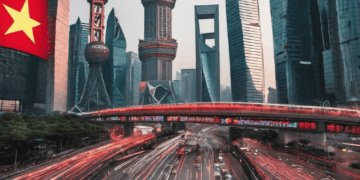China’s economic trajectory as it steps into 2020 is marked by uncertainties stemming from various global and domestic factors.
The recent ‘phase one’ trade agreement between the US and China might indicate a momentary relief in bilateral tensions, yet the broader issues persist. The protests in Hong Kong have subdued, but the underlying socioeconomic challenges remain unresolved. Concurrently, China continues its efforts to manage financial risks, prompting discussions about its sustained economic growth.
Amid these complexities, there are discernible trends hinting at enduring prospects for overseas investors within China.
The expanding urban middle class in China reflects evolving consumption patterns, presenting promising opportunities across lifestyle, education, and healthcare sectors. This shift extends beyond major cities, as smaller cities witness a rapid rise in their consumer class.
However, the burgeoning opportunities for investors are juxtaposed with newer complexities arising from socioeconomic and geopolitical challenges, further compounded by the ongoing trade tensions between the US and China. These challenges are intrinsic to China’s evolution as a maturing economy seeking a larger global presence.
Anticipating China’s trajectory in 2020 for foreign investors involves considering a few key aspects:
- Persistent Trade and Tech Tensions: While the ‘phase one’ trade deal signified progress, it did not fully resolve the underlying disputes. The longevity of tariffs and ongoing negotiations, coupled with the upcoming US elections, adds uncertainty. Concurrently, technology decoupling between China and Western countries is poised to reshape the investment landscape regardless of trade agreements. China’s pursuit of self-sufficiency in high-tech industries fuels this transformation.
- Moderating Growth: China’s economic planners are likely to set a growth target lower than previous years, aiming for sustainable development and debt management. Striking a balance between growth, debt control, and political objectives remains a priority, particularly with the Communist Party’s centenary approaching.
- Maturing Consumption Trends: With a shifting focus from investment-led growth to consumer-driven economy, China’s middle class is steering consumption patterns. While major cities are becoming saturated, smaller cities are emerging as hotspots for market expansion, especially in lifestyle, education, and healthcare sectors.
- Potential Reforms: The anticipation of economic reforms in 2020 is rife, given China’s history of unexpected policy shifts. Probable reforms might revolve around VAT simplification or adjustments in family planning policies, while more intricate changes, like property tax introductions, seem less likely due to complexities and sensitivities.
Navigating the intricate landscape of China’s economy in 2020 requires vigilance and adaptability. The interplay of geopolitical dynamics, domestic policies, and evolving consumer behavior will shape investment opportunities and challenges for foreign investors in the year ahead.
Catch the latest supply chain news at The Supply Chain Report. Learn more about international trade at ADAMftd.com with free tools.
#ChinaEconomicOutlook #ChinaTradeTensions #ChinaMiddleClass #USChinaTradeAgreement #ChinaGrowthForecast #ConsumerDrivenEconomy #ChinaTechTensions #ForeignInvestmentChina #China2020Reforms #ChinaUrbanization #LifestyleEducationHealthcare #ChinaConsumptionTrends #ChinaGeopolitics #ChinaEconomicGrowth #ChinaInvestors #ChinaEconomicChallenges #ChinaTradeWar #ChinaMatureEconomy #ChinaEconomicRisks

















